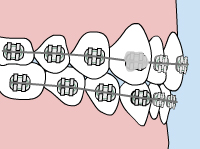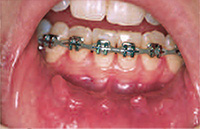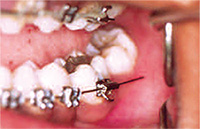Emergency Care
True orthodontic emergencies are rare, but when they occur we are available to you. As a general rule, you should call our office when you experience severe pain or have a painful appliance problem you can’t take care of yourself. We’ll be able to schedule an appointment to resolve the problem.
You might be surprised to learn that you may be able to solve many problems yourself temporarily until you can get to our office. If there is a loose piece that you can remove, put it in a plastic bag or envelope and bring it with you to your next appointment. If your braces are poking you, put soft wax on the piece that’s sticking out. If the wire has slid to one side, you can pull it back to the other side with needle-nosed pliers, replacing it in the tube on the back tooth.
After alleviating your discomfort, it is very important that you still call our office as soon as possible to schedule a time to repair the problem. Allowing your appliance to remain damaged for an extended period of time may result in disruptions to your treatment plan.

 General soreness
General soreness
When you get your braces on, you may feel general soreness in your mouth, and teeth may be tender to biting pressures for three to five days. Stick to a soft diet until your teeth do not hurt to chew. Irritated gums and other sore spots can be relieved by rinsing your mouth with a warm salt-water mouthwash. Dissolve one teaspoonful of salt in eight ounces of warm water, and rinse your mouth vigorously. An alternative (better tasting) mouthwash is the Healthy Gums Rinse by The Natural Dentist. Placing Orabase on the affected area may also help relieve discomfort; Orabase can be found in a pharmacy. If the tenderness is severe, take Acetaminophen (Tylenol) or whatever you normally take for headache or similar pain. Aspirin, Ibuprofen (Motrin, Advil) and Naproxen Sodium (Naprosyn, Anaprox) actually slow the tooth movement, so it is not advisable to use them frequently while wearing braces.
The lips, cheeks, and tongue may become irritated for one to two weeks as they learn a new posture and become accustomed to the surface of the braces. You can put wax on the braces to lessen this. We’ll show you how!

Headgear
Sometimes discomfort is caused by not wearing the headgear as instructed by your orthodontist. Please refer to the instructions provided by your orthodontist. If the facebow (metal piece) is bent, please call our office for assistance. The headgear should hurt less the more it’s worn, so be sure you get in the prescribed number of hours.

Loose appliance
If your appliance is poking you, place wax on the offending part.

Loose bracket
If your bracket or band is still attached to the wire, you should leave it in place and put wax on it if needed for comfort. If the bracket or band can be removed easily, place it in an envelope and save it to bring to your next appointment.

Loose wire
Using a pair of tweezers or needle-nosed pliers, try to put your wire back into place. It is okay to use a piece of floss to tie the wire into place: tie the floss around the bracket in place of the missing colored o-ring. If you cannot put the wire into a comfortable position, and covering the end with wax doesn’t help, as a last resort use a small fingernail clipper to clip the wire behind the last tooth to which it is securely fastened. If the end of the wire is still sharp place wax on it.

Poking wire
Using a pencil eraser, push the poking wire down or place wax on it so that it is no longer poking.
Emergency Treatments
The following orthodontic emergencies and their treatments are listed in the order of the least severe to the most severe. Only the most severe emergencies may require immediate attention by an orthodontist. The majority of these are easily treated with a follow-up by the patient’s orthodontist.

Food caught Between Teeth
This is not an emergency, but can be a little uncomfortable or embarrassing for the braceswearing patient. It is easily fixed with a piece of dental floss. Try tying a small knot in the middle of the floss to help remove the food, or use an interproximal brush or toothpick to dislodge food caught between teeth and braces.
Ligatures come Off
Tiny rubber bands or small, fine wires, known as ligatures, hold the wire to the bracket. If a rubber ligature should come off, you may be able to put it back in place using sterile tweezers. If a wire ligature comes loose, simply remove it with sterile tweezers. If the wire ligature is sticking out into the lip but is not loose, it may be bent back down with a Q-tip or pencil eraser to eliminate the irritation.
Of course, when one ligature pops off or breaks, others may follow. Be sure to examine all ligatures. Missing or broken ligatures should be brought to the attention of the patient’s parent/ guardian, who should then inform the orthodontist.
If a rubber or wire ligature is lost, notify the parent/guardian so that the orthodontist may advise whether the patient should be seen.
Discomfort
It’s normal for a patient to have discomfort for a day or two after braces or retainers are adjusted. But it can make eating uncomfortable. Reassure the patient that the discomfort is both normal and temporary. Encourage soft foods. Have the patient rinse the mouth with warm class wimg-left ater.

Mouth Sores
Some patients are susceptible to episodes of mouth sores. While braces do not cause them, they may be precipitated or exacerbated by an irritation from braces. One or several areas of ulceration of the cheeks, lips or tongue may appear. This is not an emergency, but may be very uncomfortable for the patient. Prompt relief may be achieved by applying a small amount of topical anesthetic (such as Orabase or Ora-Gel) directly to the ulcerated surface using a cotton swab. Instruct the patient to reapply as needed.

Irritation of Lips or cheeks
Sometimes new braces can be irritating to the mouth, especially when the patient is eating. A small amount of non-medicinal relief wax makes an excellent buffer between metal and mouth. Simply pinch off a small piece and roll it into a ball the size of a small pea. Flatten the ball and place it completely over the area of the braces causing irritation. The patient may then eat more comfortably. Let the patient know that if the wax is accidentally ingested, it’s not a problem. The wax is harmless.

Protruding Wire
Occasionally, the end of a wire will work itself out of place and irritate the patient’s mouth. Use a Q-tip or pencil eraser to push the wire so that it is flat against the tooth. If the wire cannot be moved into a comfortable position, cover it with relief wax. (See Irritation of Lips or Cheeks above for instructions on applying relief wax.) The patient’s parent/guardian will need to make the orthodontist aware of the problem.
In a situation where the wire is extremely bothersome and the patient will not be able to see the orthodontist anytime soon, you may, as a last resort, clip the wire.
Reduce the possibility of the patient swallowing the snipped piece of wire by using folded tissue or gauze around the area. Use a pair of sharp clippers and snip off the protruding wire. Relief wax may still be necessary to provide comfort to the irritated area.

Loose Brackets, Wires or Bands
If the braces have come loose in any way, the parent/guardian needs to be notified, and they should call the orthodontist to determine appropriate next steps.
Brackets are the parts of braces attached to teeth with a special adhesive. They are generally positioned in the center of each tooth. The bracket can be knocked off if the patient has eaten one of those hard or crunchy foods orthodontic patients are instructed to avoid, or if the mouth is struck while at play. (Encourage all patients, especially those with braces, to wear a protective mouth guard while playing sports.)
If the bracket is off center, the adhesive may have failed. Call the parent/guardian, and recommend that they immediately notify the orthodontist, who will determine the course of action.
If the loose bracket has rotated on the wire and is sticking out and the patient cannot immediately be taken to the orthodontist, you can do a temporary fix to alleviate discomfort and prevent further damage. But take care to prevent swallowing or other injury.
To put the bracket back in place, use sterile tweezers to slide the bracket along the wire until it is between two teeth. Rotate the bracket back to the proper position, then slide it back to the center of the tooth.